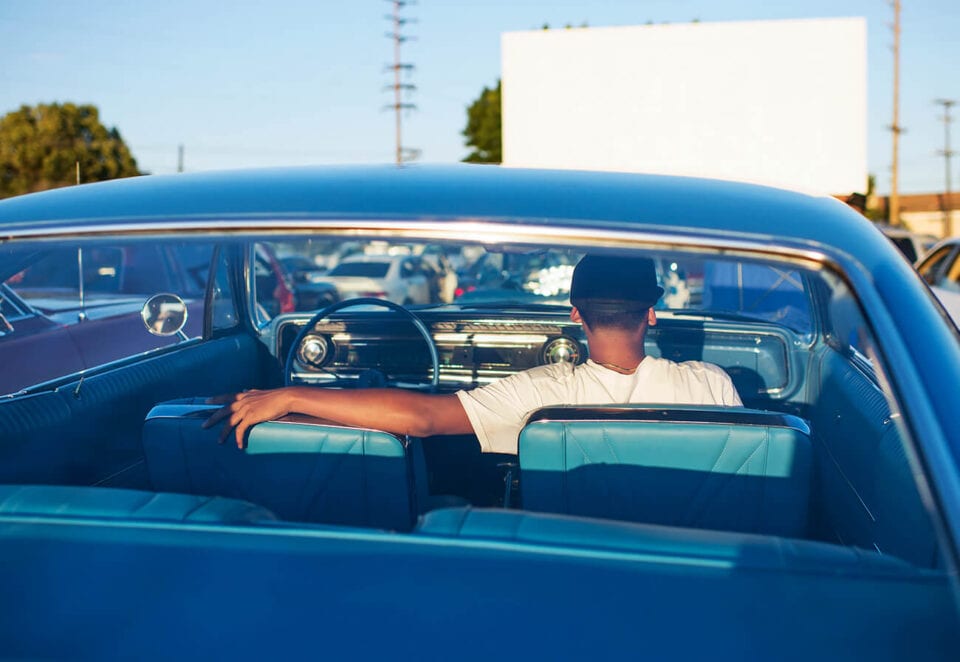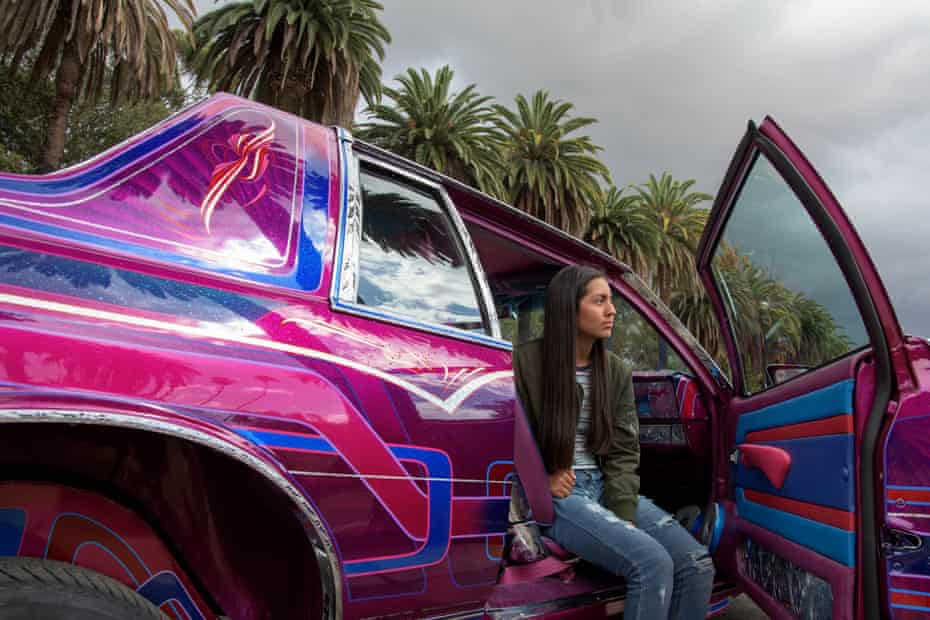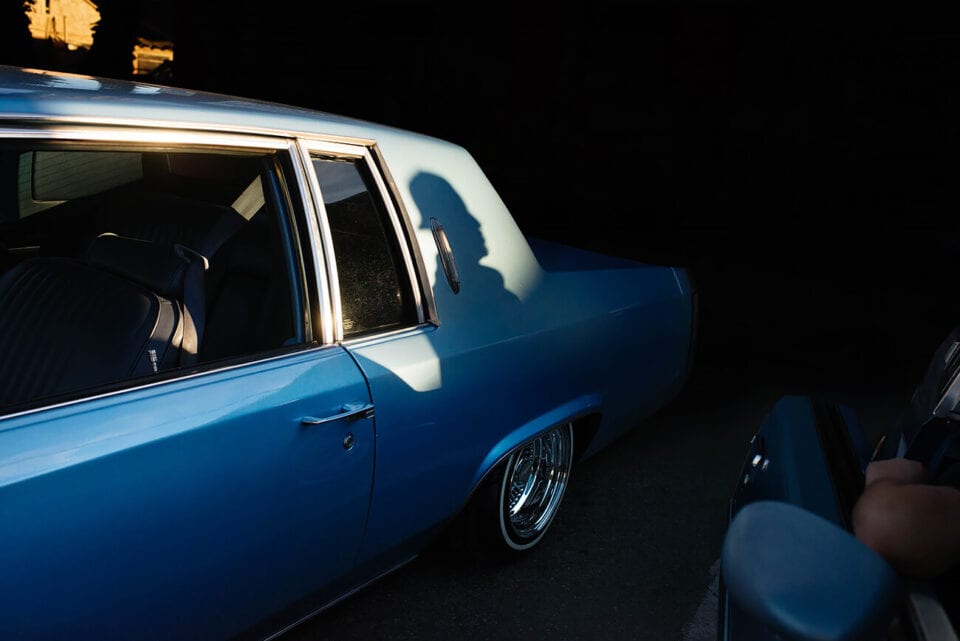Kristin Bedford can’t pinpoint the exact moment she first saw a lowrider. In Los Angeles, they’re everywhere. Driven close the ground, immaculately restored and creatively customised, with their distinctive rims and glistening candy paint jobs, these eye-catching classic cars are “part of the fabric of the city,” says the photographer, whose new book, Cruise Night, provides a uniquely meditative and reverent take on lowriding culture amongst Mexican Americans in LA. Unlike other portrayals of the scene, which tend to highlight the style and swagger of young, male lowriders, Bedford’s presents lowriding as a community – multigenerational, female as well as male – and a fine art practice, alternating intimate portraits with close-up compositions of car bodies.
Lowriding is a global phenomenon, popularised through 1990s Hip Hop videos and, more recently, Instagram. You’ll find lowriders – a term which refers both to the vehicle and the driver – in Brazil, Indonesia and Japan. But lowriding’s birthplace is LA, where it originated after WWII in the 1940s and 1950s when young Mexican Americans started modifying their cars by lowering the suspension and embellishing the exteriors with colourful designs, cruising around to dis- play their handiwork. 1958 saw the government crack down, banning vehicles with any parts lower than their wheel rims, but the well-known lowrider Ron Aguirre responded the following year with his X-Sonic car, containing a pioneering hydraulic system allowing the front of the vehicle to be raised and lowered in a bouncing motion – a technology that has since become a defining feature of all 21st century lowriders.

It was this side of the lowriding story – of creativity and resilience in the face of oppression – that first interested Bedford as a photographer. She remembered, growing up in Washington DC, her father telling her about Los Angeles Times journalist activist Ruben Salazar. He was the first Mexican American reporter to write about his community for a mainstream news outlet, and was killed by a tear gas projectile fired by sheriff’s deputy Tom Wilson whilst covering the National Chicano Moratorium March against the Vietnam War in 1970. When Bedford moved to LA, one of the first things she did was to visit the Silver Dollar Cafe where Salazar had been taking a break from his work when he died. “I asked myself: where can you find Salazar’s voice today? The answer is multifaceted.” This thinking led her to follow- ing “a curiosity about how the customisation of a car is about having a voice politically, culturally and creatively.”
Bedford attended her first “cruise night” on 27 December 2014 – an evening meet-up where lowriders from different car clubs, as well as some solo riders, drive around slowly so they can flaunt their craft and admire each other’s. She spent the next five years shooting the project on and off – spending most of her time listening, learning and getting to know people and a lesser amount actually taking pictures. In so doing, she discovered that this is an identity as much as a practice, “passed down between generations. Children are born into it,” she explains. “Lowriding is part of rites of passages, baptisms, quinceañeras, weddings, funerals, it’s completely woven into these events. It’s not a hobby for people, it’s a way of life, it’s in their DNA.” Archive images in the book – comprising photo albums or piles of vintage polaroids showing lowriders from the 1970s – attest to this fact.
That unrushed and respectful approach contrasts with the short term, “drive by” method used by other photographers who have documented this world. Juan Ramirez, co-founder Los Angeles Lowrider Community and President of Just Memories Car Club Los Angeles, says: “We are always being stereotyped, but by riding with us, she understands what we are really about and what we do.” Many more quotes are interspersed amongst Bedford’s images. She stresses: “I felt it was important to not have text from outside the community, written by supposed experts. The true experts are those who have lived it. I chose quotes that felt like magical vignettes that give you a glimpse into the experience of lowriding. I see them as a kind of poetry that’s paired with the photos.”

Not only was this ethos respectful from a social and ethical standpoint, it also translates into more powerful, authentic photographs. Unposed, her portraits feel refreshingly natural, no mean feat in an age of hyper-image awareness. Throughout the project, Bedford used only available light and a fixed lens. “The distance I appear to be is true. So, if you see a photograph from inside the car, it exists because I was invited to be there,” she says. However, beyond this working method, she didn’t set out to capture the world in a particular way. “I have no agenda at all. Intellectual interest is what brings me to the door. But once I walk through and begin making photographs, I completely turn myself over to the unknown. My work is grounded in mystery, and I let the photos reveal what the story is about for themselves.”
There’s a stillness to these shots that might seem surprising given the subject matter. We don’t get a sense of the roaring engines, the smell of petrol and the blazing California sun. People gaze beyond the frame, invoking speculation about their deepest thoughts, dreams, hopes, their inner lives beyond the brief seconds captured here. That hushed atmosphere is a hallmark of Bedford’s practice, whatever the subject matter. “When I make images, it’s like when you’re at the beach. There are all these people around, playing, making noise, listening to music, and then you go under the water. Then, all of a sudden, your reality transforms and it’s completely quiet. Your spatial proximity to those people is the same but somehow your landscape has changed.”
This sensibility feels particularly pronounced in the images of women, perhaps because they tend to feature with less frequency in other representations of lowrider culture. Whilst it’s undeniably a male-dominated tradition, there are a growing number of women lowriders and all-women car clubs. “Media coverage usually focuses on men and the role of women is reduced to sexual accessories, posing next to cars,” says Bedford. “Throughout my entire career, I’ve considered myself a photographer, but during this project I realised for the first time that I was a woman photographer specifically,” she continues. “When I saw the kind of photographs I’d made of women lowriders, I discerned that it was a woman working amongst her peers. I also reflected on why I had not seen images like this before, and it became clear to me that the visual narrative of lowriding and automotive cultures of all types, has been entirely shaped by men.”

Another revelation was in the images of details. “Before doing this project, I had primarily shot people, not objects. It was a journey to find my voice, with the cars – the metal, the reflections, the paint jobs. [In the edit] I organically found myself being drawn to the pictures that were really intimate and close. Those details are a form of personal expression.” In their minimalist attention to the most intricate elements of lowrider design, from the sparkle of light on metal, bold colours, curving shapes, velvet interiors, patterns and pictures, they’re almost abstracted from their environment. Bedford talks about working “at the intersection of aesthetics and social realism.” Nowhere is this clearer than in these images. They don’t simply document the cars’ visual appeal, but embrace, participate in and further enhance that visual allure for the viewer – a tribute to the vehicles as fine art objects.
The same can be said of the publication’s design more broadly. Bedford was encouraged by many people to give the book a “street vibe, to use a typeface associated with street art or tattooing” but she strongly resisted this in favour of an elegant and understated look that gives the images space to breathe. “I wanted the cover to be blue cloth to represent the experience of night, and I was clear from the beginning that I wanted it to have a Modernist typeface. The visual language of Modernism is prevalent and important in LA. It was another way of bringing in our landscape into the book,” she says. “With the title printed on the cover in blue metallic ink, you can never really look at the words straight on. This is what it’s like at night when you see the reflections of cars as they cruise slowly down the street. But it also references what it’s like looking at paint jobs. When you stand at different angles, they appear to be different colours.”
The USA is a country defined by vehicles, with its vast highways, drive-in movies and sprawling suburbs designed for commuting. Throughout culture, from film to literature, music and art, the car is romanticised as a symbol of individuality and of freedom. “There was nowhere to go but everywhere, so just keep on rolling under the stars,” as Jack Kerouac wrote in On The Road (1957). Yet, as Bedford points out, “the automotive, visual narrative of America has primarily been around white people. This is a narrative, focusing on the Mexican American community, which shows that their tradition is an integral part of American culture at large. I don’t see lowriding as a subculture. It is culture.”

Looking back, Ford Motor Company transformed the economy and society of the early 20th century, setting the wheels in motion for homogenisation, over-consumption and waste, with new models brought out every year. In 2020 alone, Ford sold just over four million cars to dealers worldwide. And, since Ford’s first model was produced in 1903, the ratio of people to cars has grown to be approximately 18 to one.
Lowriding is an interesting counterpoint to this mass pro- duction taking place worldwide. As elucidated in oral testi- monies in the book, lowriders invest time, energy, money and thought into putting their individual stamp on a vintage car. Care, love and nostalgia go into their creations, a concept which is at odds with the in-built obsolescence of so many consumer products offered in today’s throwaway culture.
“A lowrider finds a car that’s in bad repair and they see something, they have a personal vision of what this car can be, and then they realise that vision. Lowriding is an expres- sion of oneself and one’s imagination. Often times cars have themes, they make a political or social point, or reference your cultural heritage. And then when you’re cruising down the boulevard, it’s a mobile canvas. The world is witnessing your artwork.” In a sense, Cruise Night isn’t just about cars, but about a sense of belonging and beauty. The car is a vehicle for something else that transcends the sum of its parts.
Words: Rachel Segal Hamilton
Kristin Bedford: Cruise Night is published by Damiani | damianieditore.com
Image Credits:
1. Kristin Bedford, Gypsy Rose, Imperials Car Club, July 12, 2015 (detail). Courtesy of the artist.
2. Kristin Bedford, Impala Drive-In, August 14, 2015 (detail). Courtesy of the artist.
3. Kristin Bedford, Samantha, At It Again Car Club, May 7, 2017. Courtesy of the artist.
4. Kristin Bedford, Los Angeles, Los Angeles Car Club, July 8, 2018 (detail). Courtesy of the artist.
5. Kristin Bedford, Anthony “Too Tall”, Ordinary Life Car Club, December 27, 2014. Courtesy of the artist.





